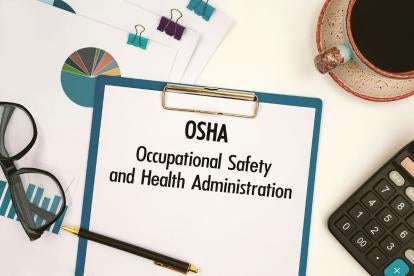Effective January 1, 2015 employers in states with Federal OSHA jurisdiction must report to OSHA all work-related fatalities (that occurs within 30 days of the work-related incident) within 8 hours of learning of the fatality, all work-related in-patient hospitalizations, all amputations and all losses of an eye within 24 hours of the work-related incident.
In order to manage the influx of new reported injuries, OSHA’s Deputy Assistant Secretary, Dorothy Dougherty issued an internal memo to all Regional Administrators on December 24, 2014 outlining interim enforcement procedures for the new reporting requirements.
This twenty some page policy provides Regional and Area offices with instructions for the intake of reports, the input of reports to OSHA’s online database, and the triage of reports that will be inspected and investigated.
Report Intake
During the initial intake of the report the new reporting requirements require employers to provide OSHA with the following:
-
Establishment name
-
Location of the work-related incident
-
Time of the work-related incident
-
Type of reportable event, i.e., fatality, amputation, in-patient hospitalization, loss of an eye
-
Name(s) of employee(s) who suffered work-related injury
-
Establishment contact person and telephone number
-
A brief description of the work-related incident
Under 1904.39 the above information is all that employers are required to report to OSHA. However, employers are likely to be asked a series of other questions when making the initial report to OSHA. Under the internal policy, employers may be asked some of the following questions:
-
What was the injured employee doing just before s/he got injured?
-
What tools, equipment, or materials was s/he using?
-
What directly caused the harm to the injured employee?
-
Is the hazard that directly caused the harm to the injured employee still in the workplace?
-
Could it potentially harm other people in the workplace? How many people?
-
What steps have been taken to remove the hazard?
-
Has something like this happened before in this workplace, or almost happened?
If presented with any of these questions, employers should take caution in responding. Legally, under the requirements of the standard they are not obligated to provide such information. And given the timeframes employers must report fatalities and certain injuries it is likely that most employers will not know what “directly caused” the harm to the injured employee. Additionally, providing information about previous accidents in the workplace can ultimately be used against employers if OSHA were to conduct an inspection. Employers are advised to inform OSHA that an internal accident investigation is currently underway.
For those employers who make reports through the Hotline or electronic submission (when that feature becomes available) Area offices have been instructed to determine if follow-up calls are necessary. So these employers may also be requested to provide additional information beyond what is required to be reported to OSHA.
Once OSHA receives the information required under the reporting requirements it will input the data into a database. Previously, Dr. Michaels indicated that the Agency was going to make these reports publically available on its website. It is anticipated that OSHA will use this database as a means to allow the public access to this information.
Triage
Depending on the type of reported injury, OSHA’s internal memorandum establishes three categories to determine whether to open an inspection which will include an actual on-site visit or to initiate a “Rapid Response Investigation (“RRI”).
All reports classified as “Category 1” will be inspected:
-
All fatalities and reports of 2 or more in-patient hospitalizations
-
Any injury involving a worker under 18
-
Known history of multiple injuries (same or similar events in previous 12 months)
-
Repeat offenders (history of egregious, willful, failure-to-abate, or repeated citations)
-
SVEP
-
National Emphasis or Local Emphasis Program
If the reported injury does not fit within Category 1, the Area Director will determine whether to conduct an inspection based on the Area Director’s discretion and/or an employer’s response to any of the following questions:
-
Are employees still being exposed to the factors underlying the hazards that resulted in the injury or illness?
-
Was the incident the result of a safety program failure such as PRCS, LOTO, PSM, etc.?
-
Was the employee exposed to a serious hazard (i.e., explosive materials, combustible dust, falls or heat)?
-
Were temporary workers or other vulnerable populations injured or made ill?
-
Has another government agency (federal, state, or local) made a referral?
-
Does the employer have prior OSHA inspection history?
-
Is there a whistleblower complaint/inspection pending?
-
Is the employer a VPP, OSHA Strategic partnership, SHARP or an active alliance member?
-
Did the incident involve health issues such as chemical exposures, heat stress?
If the answer to several of the above questions is yes the memorandum states that “the Area Office is encouraged to conduct an inspection.”
For all other reports not classified as Category 1 or 2, OSHA will conduct a “Rapid Response Investigation.” A rapid response investigation is similar to OSHA’s phone/fax procedures. If OSHA determines an on-site inspection is not necessary, it will first call the employer to inform them that a letter requesting information about the employer’s investigation into the work-related incident will be sent to the employer. OSHA will then send a letter asking the employer to complete the following:
-
Conduct an incident investigation
-
Document findings and send corrective actions
-
Post a copy of the letter where employees can readily review it
-
Fax or email a copy of the signed Certificate of Posting
The letter will establish a response date for employers; however, OSHA will allow employers to request extensions to respond. OSHA is requiring employers to provide a response within five working days “to confirm abatement/steps that have been taken for abatement.” Specifically, the Agency wants a written response and supporting documentation, such as “photos, sample results, programs, training records, receipts for equipment, etc.” to establish that the employer has conducted an investigation and abated the hazard. The memorandum includes a “Non-Mandatory Investigation Tool” that will be attached to the letter to “assist [employers[ in conducting an effective investigation…in identifying the root causes of the incident and taking the necessary steps to ensure…employees are protected from future injuries.”
Rather than simply complete the attachment, in a separate letter employers should describe the investigation it conducted, what the results of that investigation revealed and what corrective actions were or will be taken.
Once OSHA is satisfied with the employer’s response it will close out the RRI. While responding to these letters is not legally required under OSHA’s standards, the failure to provide a response is likely to result in OSHA conducting an on-site inspection.
A copy of OSHA’s memorandum on “Interim Enforcement Procedures for New Reporting Requirements under 29 C.F.R. 1904.39” can be found here.




 i
i


